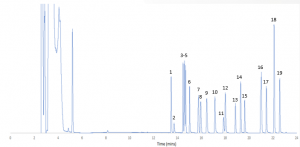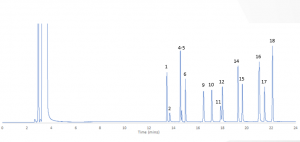ASTM D7423 - Analysis of Low Level Oxygenates (LOWOX) in Liquified Petroleum Gas (LPG)
Introduction
The determination of sub to high ppm levels of ethers, alcohols, aldehydes and ketones in different hydrocarbon matrices is a recurring challenge in the petroleum refining and petrochemical industry. The SCION low level oxygenates analyzer is designed and optimised to quantify ppm and sub levels of ethers, alcohols, ketones and hydrocarbons in gas, liquid and LPG samples.
Oxygenates can be present in hydrocarbon streams for a variety of reasons. For example, methanol is added to crude oil to reduce the formation of hydrates during transportation and storage. Clean up processes like hydro -treating are used in an attempt to remove oxygenated compounds. Even at sub ppm trace levels, oxygenates quickly degrade or destroy expensive catalysts in downstream polymerisation processes.
The SCION LOWOX analyzer measures oxygen containing hydrocarbons with a boiling range up to 100°C. Higher boiling components may be present in the sample but will not be measured; the sample final boiling point is 250°C.
ASTM D7423 is a standard test method for determination of oxygenates C2-C5 in hydrocarbon matrices. Although the LOWOX method used in this application is not the ASTM test method, due to different inlet configuration, reference will be made for repeatability testing.
Experimental
Configured with both a gas sampling valve and liquid valve, the SCION 456 GC is capable of simultaneously injecting gas, liquid and LPG samples without the need for reconfiguration.
Two high performance capillary columns are digitally controlled with a fluidic switch coupled to an FID. The sample is injected via the appropriate sampling valve onto the first of the two columns. The lighter fraction, containing oxygenates with a boiling point lower than 100°C, is separated from the rest of the stream components whilst the heavier components are backflushed to vent.
The lighter component fraction is then transferred onto the LOWOX column using the fluidic switch. The LOWOX column is used to separate individual oxygenated components from the bulk hydrocarbons.
The LOWOX analyzer is capable of operating in two modes; the wide range mode and the MTBE mode. In MTBE mode, only the components up to MTBE including the lighter components will be measured whereas in the wide range mode all components lighter than Propylether will be measured.
Varying concentrations of a multi components standard mixture is used for the calibration curve. The linear working range for the oxygenates is 0.50mg/kg to 100mg/kg. Table 1 shows the analytical conditions of the SCION 456 analyzer.
Table 1. Analytical conditions of GC-FID

Results
A LOWOX calibration standard (wide range mode and MTBE mode) was analyzed using the SCION Oxygenates analyzer. The wide range chromatogram is shown in Figure 1 whereas Figure 2 shows the MTBE range chromatogram. Table 2 details peak identification. Post analysis each of the oxygenates are automatically quantified and reported by the Compass Chromatography Data Handling Software.

Fig 1. Wide Range Chromatogram

Fig 2. MTBE Chromatogram

Table 2. Peak Identification of wide range and MTBE calibration sample.
The 19 components found in the sample are clearly separated and defined. The GC conditions were optimised to ensure complete separation of the three critical peaks; ETBE, MTBE and DIPE, all of which have a resolution of 1 or greater, in wide range mode. Maximum resolution is vital to ensure accurate quantification of each oxygenated compound.
ASTM D7423, the standard test method for determining oxygenates in hydrocarbon matrices, specifies that repeatability of the oxygenate system must be validated using ten consecutive runs for a standard blend containing 25ppm of each component. The RSD% of the area for each component must be less than 2.5%. Although this application was not running to ASTM D7423 specification, the repeatability was tested under those conditions. Repeatability data for the three critical components can be found in Table 3.

The SCION Oxygenates analyzer shows excellent repeatability with ten consecutive injections having an RSD% of <0.40 for the three critical peaks.
Conclusion
The SCION Oxygenates analyzer is a dedicated solution for accurate determination of trace oxygenates in hydrocarbon matrices. The ability to be operated in both wide range mode and MTBE mode allows the Oxygenates analyzer to be highly selective. Due to its selectivity, large amounts of sample can be introduced onto the LOWOX column and combined with the sensitive FID, low level detection of oxygenated compounds is made easy. The repeatability performance exceeds that of the requirements of ASTM D7423.
Download the Application Note
Download the complete Application Note: Analysis of Low Level Oxygenates (LOWOX) in Liquified Petroleum Gas (LPG)
SCION Gas Chromatography Analyzer
A SCION Gas Chromatography Analyzer was used to conduct this research. Providing excellent solutions for Environmental, Oil and Gas and Chemical industries, find out more about Scion GC Analyzers.
Alternatively if you would like to speak to a member of our team for more information, please don’t hesitate to get in touch. We look forward to being of assistance.
To stay in the loop regarding future research and articles from SCION Instruments, why not join us on social media and sign up to our eNewsletter?
